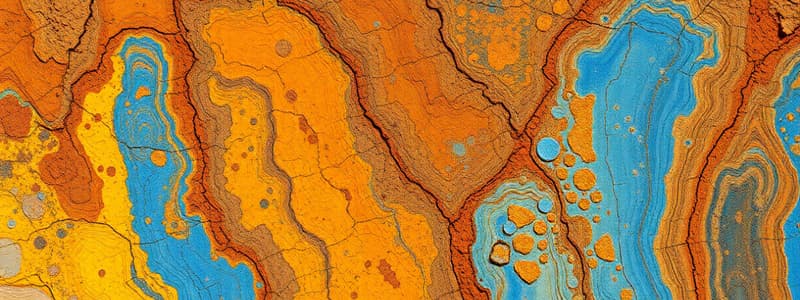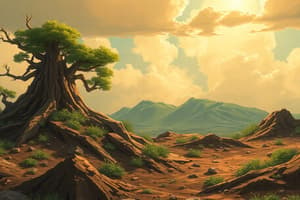Podcast
Questions and Answers
How does physical weathering typically influence the exposed surface area of rocks and, consequently, affect the rate of chemical weathering?
How does physical weathering typically influence the exposed surface area of rocks and, consequently, affect the rate of chemical weathering?
- It decreases the surface area, which decelerates chemical weathering.
- It increases the surface area, which decelerates chemical weathering.
- It increases the surface area, which accelerates chemical weathering. (correct)
- It decreases the surface area, which accelerates chemical weathering.
In what way does chemical weathering generally impact the rate at which physical weathering occurs?
In what way does chemical weathering generally impact the rate at which physical weathering occurs?
- It accelerates the rate of physical weathering. (correct)
- It slows down the rate of physical weathering.
- It has no impact on the rate of physical weathering.
- It temporarily increases, then decreases the rate of physical weathering.
Which combination of land management practices is most effective in minimizing soil erosion on a sloped agricultural field?
Which combination of land management practices is most effective in minimizing soil erosion on a sloped agricultural field?
- Increasing the slope angle in combination with plowing along the slope's direction.
- Decreasing the slope angle in combination with plowing perpendicular to the slope. (correct)
- Decreasing the slope angle in combination with plowing along the slope's direction.
- Increasing the slope angle in combination with plowing perpendicular to the slope.
Considering the factors influencing weathering, which location from the table will most likely exhibit the most pronounced weathering of marble statues over a 50-year span?
Considering the factors influencing weathering, which location from the table will most likely exhibit the most pronounced weathering of marble statues over a 50-year span?
In a concept map illustrating weathering processes, what term accurately describes the category to which physical processes such as wedging and abrasion belong?
In a concept map illustrating weathering processes, what term accurately describes the category to which physical processes such as wedging and abrasion belong?
In a concept map illustrating weathering processes, what main category describes weathering where rock dissolves?
In a concept map illustrating weathering processes, what main category describes weathering where rock dissolves?
In a detailed outline of weathering mechanisms, to which category would 'wedging' be most accurately assigned?
In a detailed outline of weathering mechanisms, to which category would 'wedging' be most accurately assigned?
In a thorough classification of weathering phenomena, which category best encompasses the impact of repeated freezing and thawing cycles on rock structures?
In a thorough classification of weathering phenomena, which category best encompasses the impact of repeated freezing and thawing cycles on rock structures?
In the context of weathering taxonomy, under what main category would one classify the process of dissolution and oxidation?
In the context of weathering taxonomy, under what main category would one classify the process of dissolution and oxidation?
Based on the policy analysis, what was the prevailing hypothesis regarding the impact of incentive programs on soil conservation efforts in the U.S. agricultural sector?
Based on the policy analysis, what was the prevailing hypothesis regarding the impact of incentive programs on soil conservation efforts in the U.S. agricultural sector?
Which soil conservation practice is primarily aimed at reducing soil erosion caused by high wind velocity?
Which soil conservation practice is primarily aimed at reducing soil erosion caused by high wind velocity?
What soil conservation strategy is most directly linked to enhancing the character and structure of the soil itself, thereby reducing erosion?
What soil conservation strategy is most directly linked to enhancing the character and structure of the soil itself, thereby reducing erosion?
What is the primary soil conservation benefit of maintaining a consistent vegetative cover on the land?
What is the primary soil conservation benefit of maintaining a consistent vegetative cover on the land?
Which soil conservation technique is specifically designed to counteract the effects of a steep land surface on soil erosion?
Which soil conservation technique is specifically designed to counteract the effects of a steep land surface on soil erosion?
What roles do weathering and biological activity play in the context of soil development?
What roles do weathering and biological activity play in the context of soil development?
How is erosion best defined in the context of soil and landscape processes?
How is erosion best defined in the context of soil and landscape processes?
Which specific type of chemical weathering is primarily responsible for the formation of rust on the surface of rocks and other materials?
Which specific type of chemical weathering is primarily responsible for the formation of rust on the surface of rocks and other materials?
What term accurately describes the type of chemical weathering that occurs when water acts as a solvent to dissolve minerals?
What term accurately describes the type of chemical weathering that occurs when water acts as a solvent to dissolve minerals?
What is the dominant mechanism by which ions are transported out of soil profiles, leading to the depletion of certain elements?
What is the dominant mechanism by which ions are transported out of soil profiles, leading to the depletion of certain elements?
What sequence accurately represents the typical arrangement of soil horizons from the uppermost surface layer to the deepest layer?
What sequence accurately represents the typical arrangement of soil horizons from the uppermost surface layer to the deepest layer?
Flashcards
Physical Weathering Impact
Physical Weathering Impact
Physical weathering increases surface area, enhancing chemical weathering rates.
Chemical Weathering Influence
Chemical Weathering Influence
Chemical weathering enhances the rate of physical weathering by weakening rock structures.
Optimal Soil Conservation
Optimal Soil Conservation
Plowing across the slope and decreasing slope angle are effective soil conservation techniques.
Weathering Factors
Weathering Factors
Signup and view all the flashcards
Physical Weathering
Physical Weathering
Signup and view all the flashcards
Chemical Weathering
Chemical Weathering
Signup and view all the flashcards
Hypothesis on Incentive Programs
Hypothesis on Incentive Programs
Signup and view all the flashcards
Wind Erosion Control
Wind Erosion Control
Signup and view all the flashcards
Soil Character Improvement
Soil Character Improvement
Signup and view all the flashcards
Soil Erosion Prevention
Soil Erosion Prevention
Signup and view all the flashcards
Contour Plowing
Contour Plowing
Signup and view all the flashcards
Crucial Soil Formation Processes
Crucial Soil Formation Processes
Signup and view all the flashcards
Removal of Materials
Removal of Materials
Signup and view all the flashcards
Rust Formation
Rust Formation
Signup and view all the flashcards
Dissolution Definition
Dissolution Definition
Signup and view all the flashcards
Ion Removal
Ion Removal
Signup and view all the flashcards
Soil Horizon Order
Soil Horizon Order
Signup and view all the flashcards
Eluviation Location
Eluviation Location
Signup and view all the flashcards
Surface Horizon
Surface Horizon
Signup and view all the flashcards
US Wind Erosion Hotspot
US Wind Erosion Hotspot
Signup and view all the flashcards
Study Notes
- Physical weathering increases the surface area of rocks, thereby increasing chemical weathering.
- Chemical weathering increases physical weathering.
- Decreasing slope angle and plowing across the slope best reduces soil loss from a sloped field.
- Cumberburg and Dumble will undergo the most weathering in a 50-year period.
- The correct order for a soil horizon from the surface down is O, A, E, B, C.
- Eluviation occurs in the E horizon.
- Soil erosion by wind occurs most in the Great Plains.
- Regolith is not essentially the same as soil.
- Soils are a non-renewable resource.
- Biological weathering is essential for soil formation.
- Biological weathering occurs at both the macro- and micro-levels.
- Quartz is not easily weathered compared to other minerals.
- Porosity does not describe how rapidly water moves through a rock.
- Permeability describes how rapidly water moves through a rock.
- High temperatures increase the rate of chemical weathering.
- Basalt parent rock would not form a soil very similar to that formed from granite.
Weathering Concept Map
- Number 1 is Physical
- Number 2 is Chemical
- Number 3 is Wedging
- Number 4 is Unloading
- Number 5 is Hydrolysis
U.S. Agricultural Policy
- Incentive programs were not encouraging soil conservation as intended.
Soil Erosion
- Wind velocity: Provide shelter for fields
- Character of the soil: Return organic matter to soil
- Maintain vegetation: Keep soil covered
- Slope of the land surface: Contour plowing
Soil Formation
- Weathering and biological activity play the most important role in soil formation.
Removal of Materials
- Erosion is the process of removal of materials.
Chemical Weathering
- Oxidation causes rust to form.
- Dissolution happens when minerals dissolve in water.
Ion Removal
- Leaching is the main way by which ions are removed from soils.
Soil Horizon
- The O Horizon is where we walk on.
- Fractured rocks weather more rapidly than unfractured rocks.
- The volume increases when water changes to ice.
- Carbonic acid forms by a combination of carbon dioxide and water.
- The pH value of a solution increases with increasing concentrations of hydrogen ions.
Studying That Suits You
Use AI to generate personalized quizzes and flashcards to suit your learning preferences.




